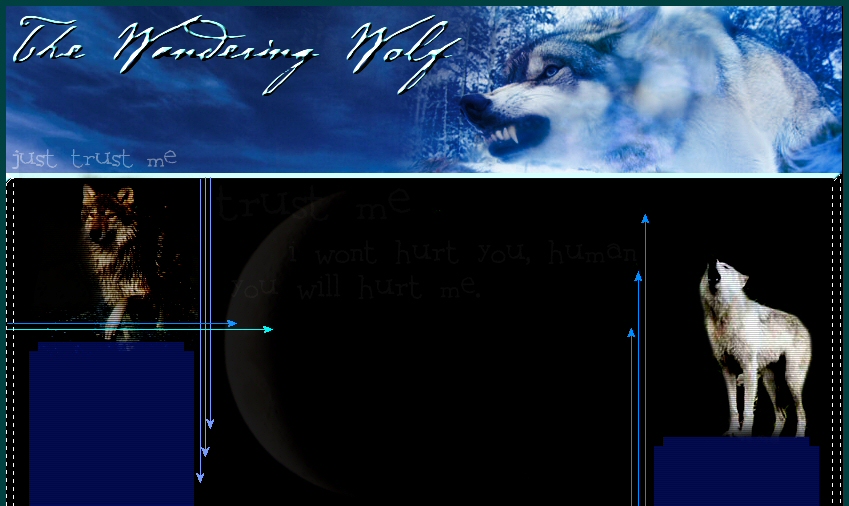

.: The Wolves :.
.: WSC Animals :.
.: The Cub :.
.: The Handwriting
.: My ABCs
.: The Basics
.: Googlism of Jade
.: The Pictures
.: The Pets
.: The Quizzes
.: The Art
.: Sister Sites :.

.: The Site :.
.: For A Wanderer
.: Competition :.
.: Contact :.
.: The Arctic Wolf :.

Adaptation: These wolves have adapted extremely well to their snowy, icy environment. They usually sport blinding white coats which allows them to blend easily into the endless, icy tundra. They also have quite an ingenious adaptation to fight the cold which normally results in heat loss. They have much more rounded ears, and also a shorter muzzle and legs. They also have more, thicker hair then other subspecies of gray wolves have between their toes. Also, as you can see in the picture above, they have a thick, sock-looking section of fur around their lower leg.
Another interesting adaptation relating to the low amount of prey in the Arctic regions is that these Arctic wolves must have at least 1000 miles of territory versus other smaller territories. They have also sucumb to eating very uncommon prey for a wolf, such as Peary caribou, ptarmigan, lemmings, seals, and nesting birds.
Pups: Because of the icy tundra, burrowing is virtually impossible when it comes time for housing the pups. Instead, they will burrow in outcroppings, rocky caves, or even shallow depressions in the ground. the An average of about 2-3 pups are born in late spring, about a month later then the southern subspecies. The small size of the litter again relates back to the scarcity of prey, but litters of up to 6 have been recorded. When the pups are born they are about 1 pound, and their eyes, and nose are closed. They are also not born with the signature white color, but a light brown. The mother will usually stay with them for a large majority of the time, but even the pups are well adapted and can be left alone for a small amount of time even in just a shallow impression.
At about the age of 10-14 days, the eyes of the pups open, then about a week later the pups begin venturing from the den. They will venture farther and farther as they gain more experience, but will race back to the den as soon as a bark from the mother or another sudden noise is heard. If they go beyond the mother's liking, she will pick them up by the scruff of the neck (where extra skin for this purpose is found) and carry them back to the den. As the pups age, they begin taking trips alone reaching about a mile away from the den.
Experience can be gained by play in puphood, and they will play with hides of animals as well as feathers and bones. Playing with each other can give them insight of whats to come as well as use some of their built-up energy. Activity also aids in warmness.
When the pups reach an age of 5 weeks they leave to a second den. During many occasions the adults will howl for different reasons at which times the pups will whine. This whining will gradually turn into high-pitched howls. Two weeks later, the pups bodily features begin to morph closer into adult form. In the legs and muzzle this means elongation, while in the chest it becomes broader. The feeding processes become somewhat different at this age, as adults will return with food in their stomachs, and the regurgitational processes begin. The pups run around excitedly, as many domestic dogs (Canis familiaris) do today when the idea of food is presented to them. They shake the entire rear ends of their bodies and lick the edges of the adults mouths, this stimulates regurgitation.
At around 8 weeks of age the wolves travel to their rendezvous point. Here, they begin 'studying' many skills they will need in adulthood. They will most likely pounce on anything that moves, and consume small eggs or other edible ground-dwelling meat by themselves. The adults will then still hunt for them, but bring back whole, large game for them to consume on their own. By about 10 weeks, the pups will leave and return to the rendezvous site on their own.
Winter begins approaching as the pups age to 4-5 months old. Since the rendezvous site is not very sheltering, the pups will take to standing on the leeward side of rocks where there is a windshadow. At about 5-6 months old, the life of arctic pups and arctic wolves in general becomes nearly unknown, as winter finds them in 24 hours of darkness.
As spring comes to the Arctic again, and the ice cracks open, the other pack members teach the surviving pups to hunt for seals. At this point, the pups are nearly 1 year old. Some of them will stay in the pack and assist in caring for the new pups, while others will venture off and try to find a mate and territory of their own.